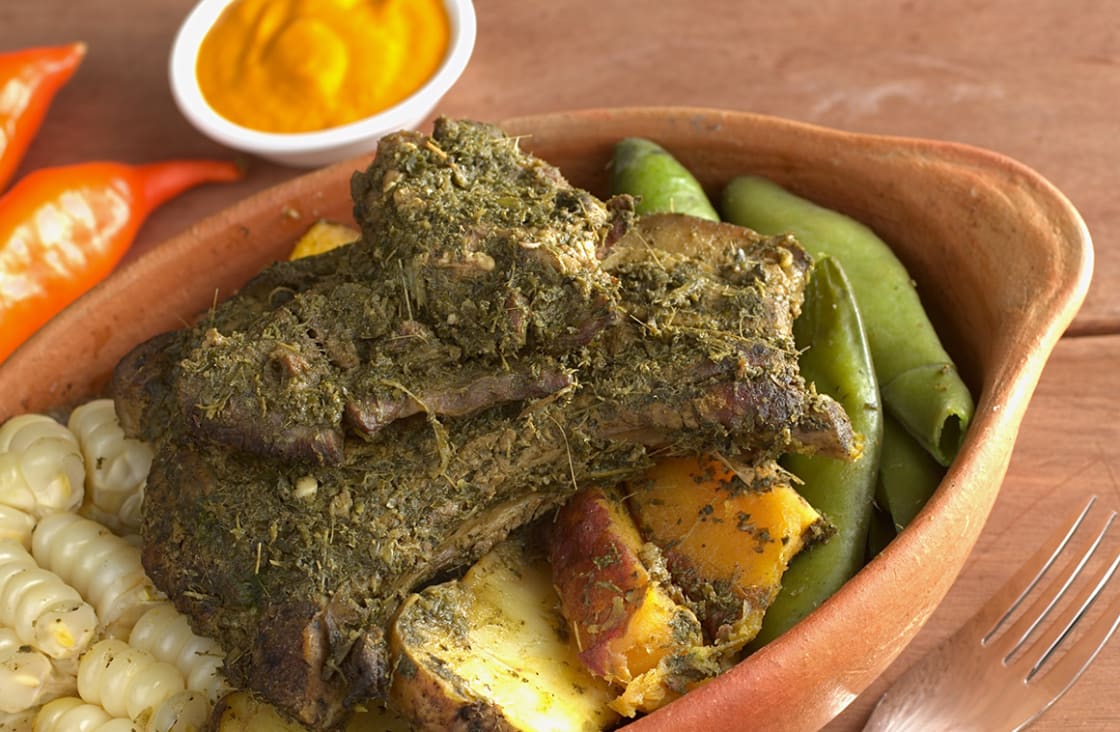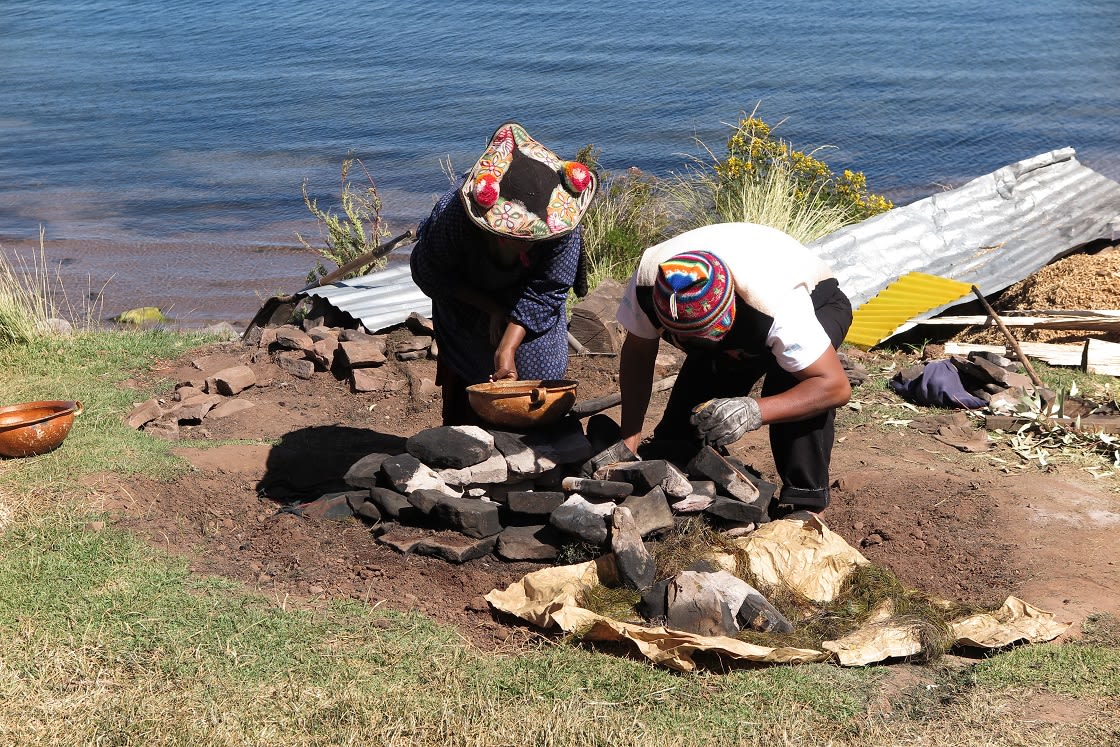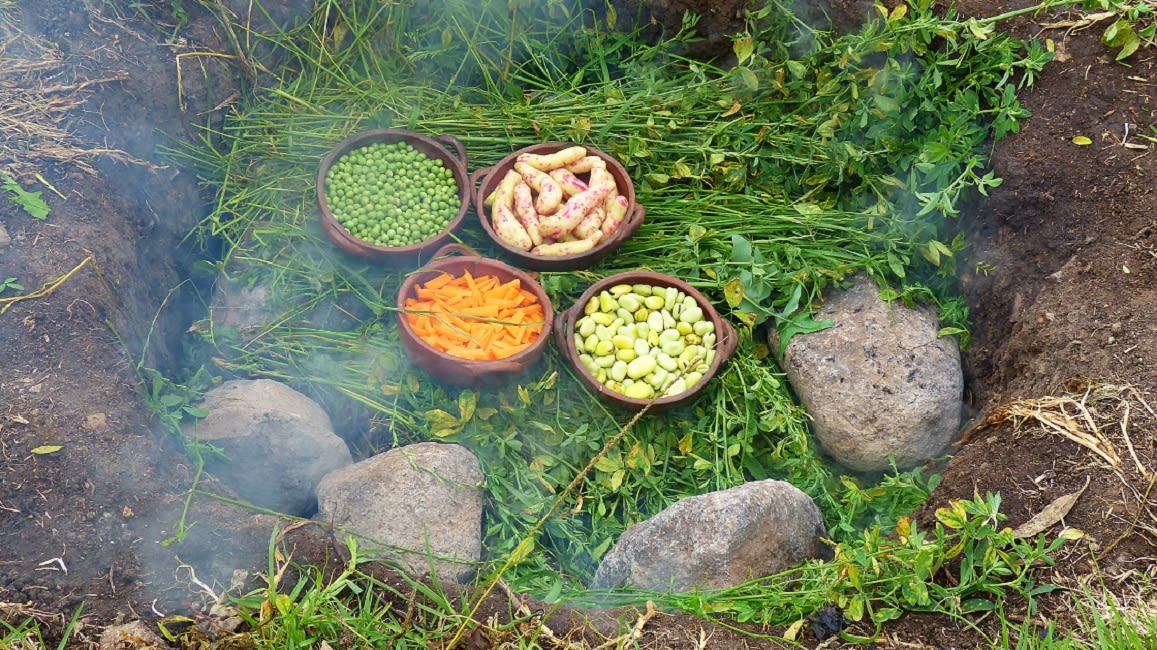
Peru is a country known for its traditional yet inventive cuisine, with each region of the country offering dishes that maximize the unique ingredients found within them. On the coast, the pride is in the fresh seafood. In the jungle, you’ll find plates bursting with exotic fish and fruits. And in the Peruvian Andes, you’ll find hearty ingredients cooked by one of the oldest culinary traditions of them all: Pachamanca. Cooked over the course of several hours, the Andean dish of pachamanca involves a mixture of heavily spiced meat and vegetables buried amidst hot stones. Read on to learn more about the pachamanca technique, and its role in Peruvian culture.
Quechua for “earth oven” or “earth pot”, Pachamanca specifically refers to the technique of cooking the food underground with hot stones, as the dish can be made with many variations of Andean ingredients. These usually include several types of marinated meats native to the highlands, such as lamb, goat, pork, chicken, alpaca or even guinea pig (called “cuy” in Peru). Sometimes a whole animal is cooked! Vegetables such as potatoes, green lima beans, sweet potatoes, yucca, corn, tamales, humitas and chiles are also included.

Pachamanca, Peruvian Cooking Method, Dating Back To The Incas
So, how exactly is the food cooked underground with hot stones? Preparation begins digging a hole and then heating of stones over a fire (only volcanic stones will do as they can withstand the intense heat without breaking).
While the stones are heating, its time to do some seasoning and soaking. Your choice of meat (chicken, pork, beef, lamb, goat) should be well marinated with spices and herbs of the region like huacatay and chincho, hot peppers (ají), cumin, chicha, garlic and salt. You’ll then need to soak fava beans, corn and what will be your dessert – some pre-prepared sweet humitas (Andean corn tamales made with cinnamon, raisins and condensed milk) in water. This soaking will keep them from scorching whilst cooking.
When the stones are hot enough, they are placed inside the hole, lining it to create an underground oven. Now it’s time to load the oven in a specific order: the toughest and longest cooking ingredients such as sweet potatoes and cassava are places at the bottom, next up the meat, and a layer of damp banana leaves are then added to trap heat and aid steaming. On top of these are placed the remaining ingredients: the fava beans, corn and humitas. The food is then covered with a few more herbs for good measure, more damp banana leaves, some burlap cloth, and finally carefully concealed with a couple of inches of soil. The oven then remains closed for 2 – 4 hours allowing the contents to cook slowly.
The wait is, for many, the most festive part of the feast, a time to enjoy a cerveza (beer) or glass of chicha de jora ( fermented maize drink). When the food has finished cooking, this undergound oven is opened to much celebration, releasing the most wonderful, mouthwatering aroma. The meat and vegetables will have a rich, smoky flavor, and everything has the texture somewhere between steamed and grilled. Meat comes out tender, and the cooking of all the ingredients together leads to a heady and hearty combination of flavors.

Cooking Underground, Is Also A Tradition On Lake Titicaca, Peru
A culinary tradition since the Inca Empire, pachamanca has long been an important part of Peruvian cuisine. There is even evidence than the technique pre-dated written records, but researchers aren’t sure exactly how long ago it began. The preparation, like many parts of Inca culture, was all about the ritual. Preparing the pachamanca was meant to be a celebration of life, the food offering fertility and rejuvenation. The Incas believed that cooking the food underground offered respect to Pachamama, the Incan “Mother Earth”, as the food was returned to the earth before being eaten.
Since then, the dish has only slightly evolved, with some regional variations to cooking techniques as the dish has spread throughout the country (and even into Chile and Ecuador).
Today, pachamanca is the centerpiece of many Peruvian gatherings, whether it be a local holiday in the Andes or a party in the highlands just outside of Lima. it’s a great way to feed a crowd, and reiterates the important tie between food, ritual, and people in Peruvian culture.

Ollucos, Carrots, Beans, And Peas Being Cooked Over The Underground Oven
Originally from the highlands, Pachamanca is traditionally found in three main regions within the central Andes of Peru, each with a local touch.
In the upper Huallaga Valley, the dish is made with pork and seasoned with a local herb called “chincho”. In the Mantaro Valley, including the area around Huancayo, Tarma and Jauja, pachamanca is made with lamb and a variety of local seasonings. In several areas throughout Ayacucho, the dish is prepared with a less specific variety of spices and ingredients.
And now, as the dish has become a popular way to feed a hungry crowd, you’ll see it cropping up in many areas outside the Andes, even in the cities along the coast – all you need is enough earth to build it, a hungry crowd, and a pachamanca guide who knows the art of the earth oven!
For those who have the chance to visit the Andes of Peru, you won’t want to miss digging into some delicious pachamanca! Watch the artful technique in person and taste the age-old Inca tradition for yourself. It certainly won’t be a meal you’ll forget anytime soon! For more information about booking a Pachamanca tour in Peru, contact us.
While Rainforest Cruises aim to provide accurate and up-to-date information, we make no representations as to the accuracy or completeness of any information herein or found by following any link on this site. Rainforest Cruises cannot and will not accept responsibility for any omissions or inaccuracies, or for any consequences arising therefrom, including any losses, injuries, or damages resulting from the display or use of this information.




